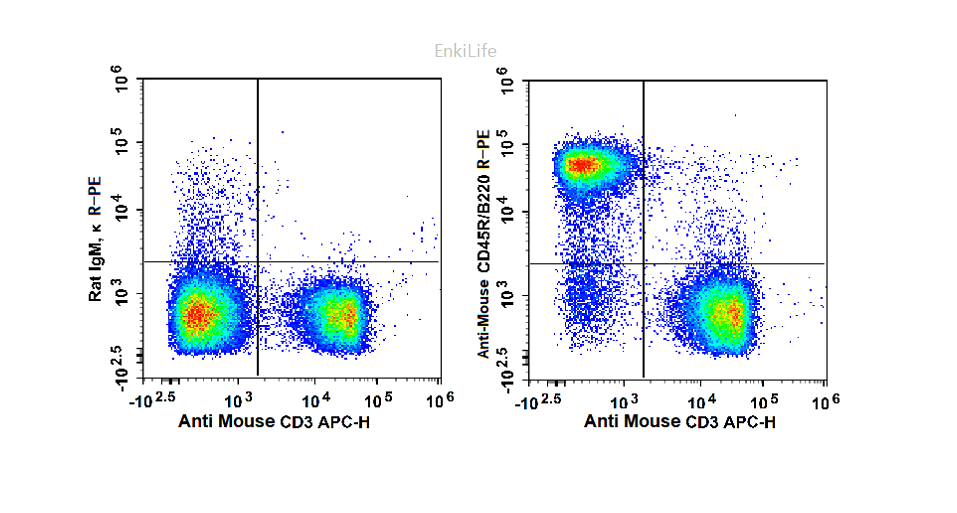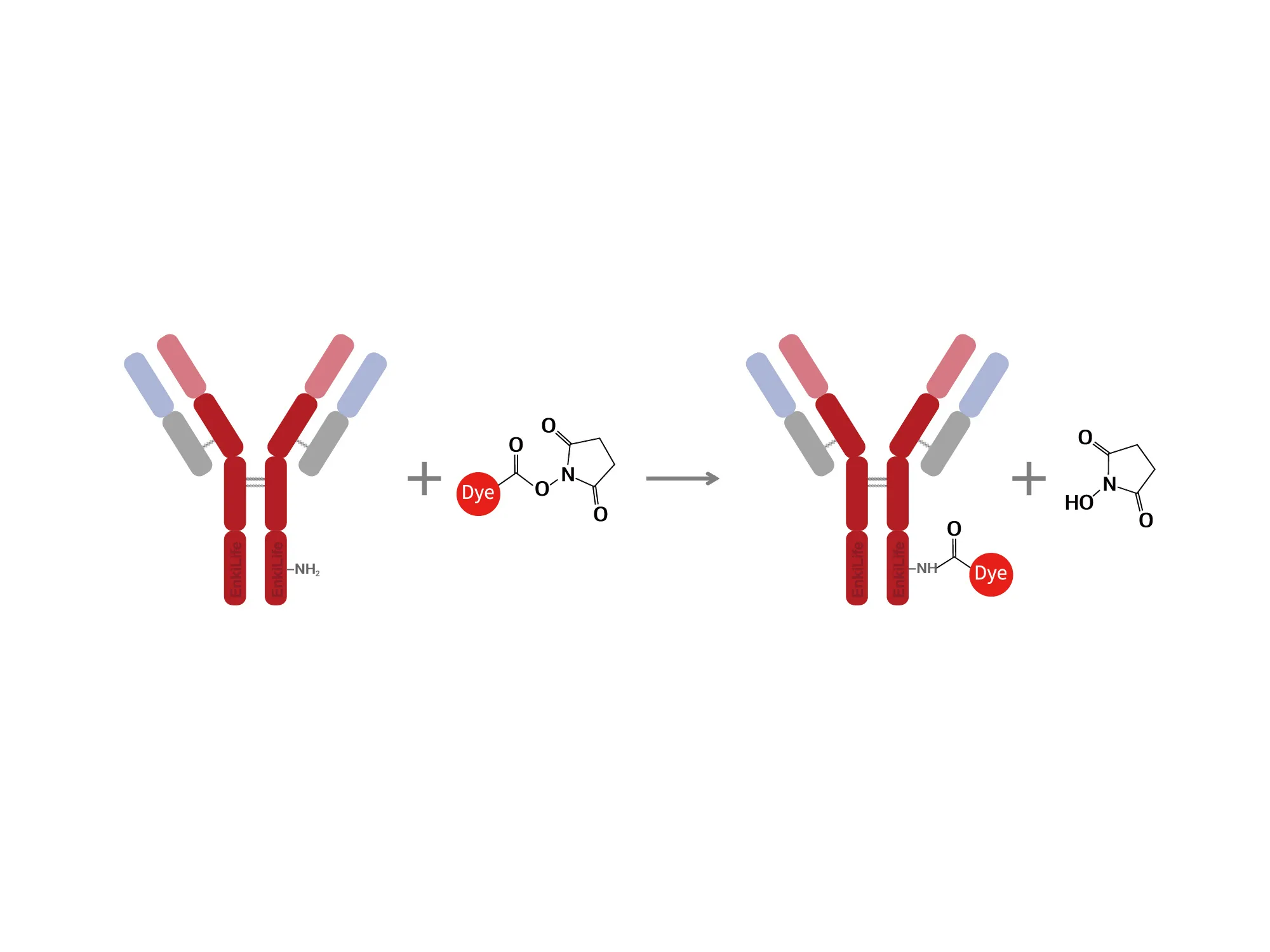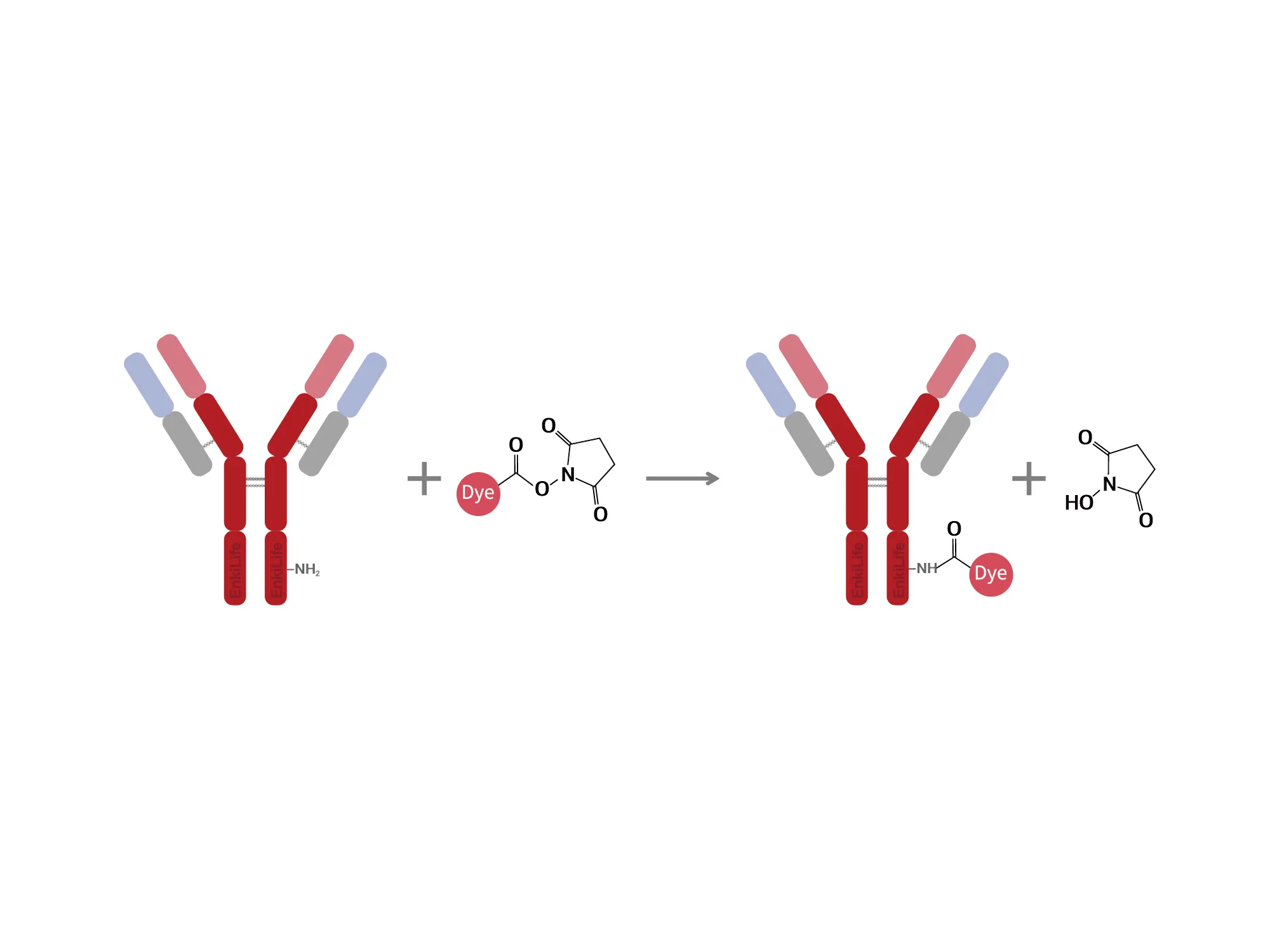Product Overview
EnkiLife R-PE labeling kit contains multiple components for labeling antibody proteins, such as the activated lyophilized R-PE fluorescent dye, labeling buffer, and other chemical reagents, enabling easy and reliable antibody labeling for use as fluorescent probes.
Product Features
- Activated dye with extended arm:A specially designed long flexible arm minimizes spatial hindrance between antibodies and the fluorescent dye. This protects antibody activity and enhances labeling efficiency.
- Site-specific conjugation:Optimized site-specific conjugation technology ensures uniform antibody labeling and improves efficiency.
- Rapid process:The simple procedure allows for efficient labeling completion in as fast as 3 - 4 hours.
- High dye brightness: The selected high-performance fluorescent dye boasts high quantum yield and brightness, ensuring high detection sensitivity.
- Dye stability:The chosen high-performance fluorescent dye is stable, resistant to degradation, and suitable for various subsequent applications, such as fixed sample detection.
- User-friendly operation:Each dye reagent is pre-optimized for corresponding antibody amounts. No complex calculations or ultrafiltration steps are required if the antibody sample meets the labeling conditions. The solid dye form ensures batch stability. Simply mix the reagents according to the steps to achieve good results.
- Flexibility: In the large-scale kit, the dye is pre-portioned for consistent batch performance, facilitating multiple labeling uses.
- Comprehensive reagents: The kit includes a labeling preservation solution, covering the entire process from labeling to preservation. No additional reagents are needed, making the process worry-free and convenient.
Dye Introduction
R-Phycoerythrin (R-PE) is a phycobiliprotein isolated from red algae, possessing an extremely high quantum yield and emitting bright orange-red fluorescence. It is an exceptional fluorescent labeling dye widely used in biological detection. Phycoerythrin primarily exists in two forms, R-PE and B-PE, which differ somewhat in their optical properties; the reagent kit described utilizes R-PE. R-PE has a major absorption peak at 565 nm, with minor peaks at 496 nm and 545 nm. Absorption spectra of R-PE can vary slightly between species. R-PE is composed of α, β, and γ subunits, existing in the form (αβ)6γ, with a complete molecular weight of approximately 240,000 Da.
Activated Dye Properties
Basic Characteristics
Synonyms:PE, Phycoerythrin
Molecular Weight: ~ 240 kDa
Common Excitation Sources: 488 nm, 532 nm, 561 nm
Maximum Excitation Wavelength:496 nm, 566 nm
Maximum Emission Wavelength: 576 nm
Molar Extinction Coefficient (L/(mol・cm)): 1960000
Purity:A566/A280 ≥ 5.3
Solubility:Highly soluble in aqueous solutions
Appearance:Red solid
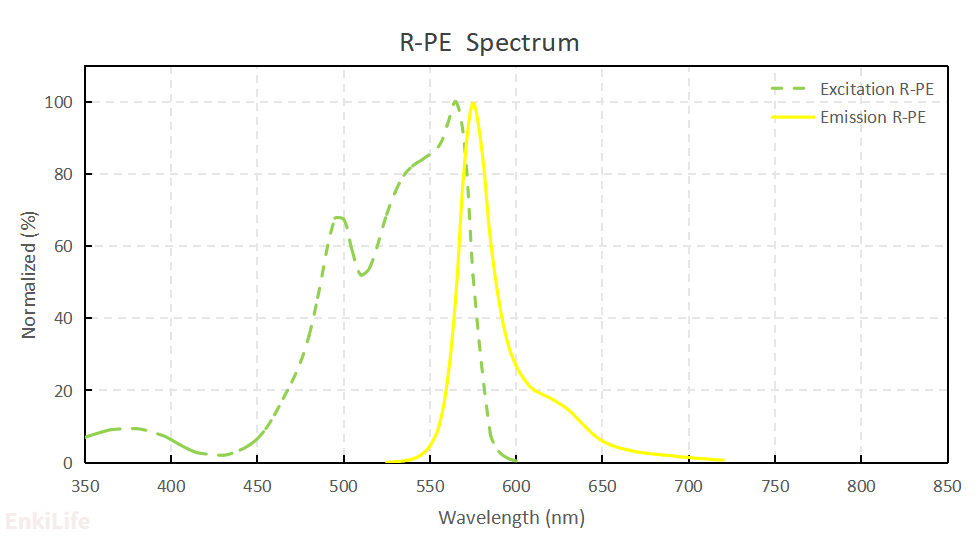
Kit Specifications
| Product Components | Component Content in Different Specifications | Storage Temperature | ||
|---|---|---|---|---|
| 40μg Antibody | 200μg Antibody | 1mg Antibody | ||
| Activated R-PE | 1 tube | 1 tube | 5 tubes | -20°C after opening, protected from light |
| Labeling Buffer L | 2 mL | 2 mL | 2 mL | 4 °C, away from light |
| Antibody Modification Reagents | 60 μL | 60 μL | 60 μL | -20 °C, away from light |
| Ultrafiltration Tube * ,50K MWCO | 1 set ** | 1 set ** | 1 set ** | RT |
| Blocking reagent | 300 μg | 300 μg | 300 μg | -20 °C, away from light |
| DMSO (dissolve blocking reagent) | 50 μL | 50 μL | 50 μL | -20 °C, away from light |
| Labeled protein storage solution | 200 μL | 1 mL | 5 mL | 2-8 °C |
| Recommended amount of labeled antibody | Each tube dyes for labeling 20-40μg antibody Recommended: 20μg antibody | Each tube dyes for labeling 50-200μg antibody Recommended: 100μg antibody | Each tube dyes for labeling 50-200μg antibody Recommended: 100μg antibody | 2-8 °C |
* * Ultrafiltration tube molecular weight cutoff: 50KDa
** 1 set = 1 ultrafiltration tube and collection tube
Labeling Principle
This kit utilizes the cysteine characteristics of the antibody and the free amino groups on the dye to covalently couple the antibody molecule with the dye using a directed docking coupling technique.

Standard Labeling Procedure
- STEP 1:Ultrafiltration buffer exchange and concentration (optional)
- STEP 2:Antibody activation
- STEP 3:Labeling reaction
- STEP 4:Quench/Blocking and preservation
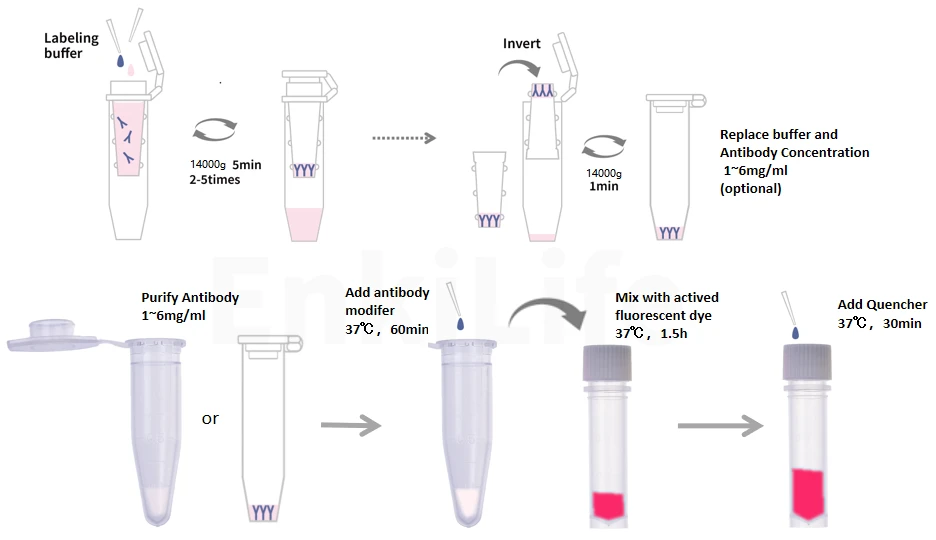
Data of R-PE labeling kit application
Flow Cytometry Analysis
FC experiment of mouse lymphocyte using FC antibodies preparaed with two kinds of labeling kits
- Sample: mouse spleen lymphocyte cells from C57BL/6 mice
- Antibody: PE anti-mouse CD45R/CD220 antibody and APC anti-mouse CD3 antibody preparaed with two kinds of labeling kits(RE80005p and RE80006p)
- Isotype control: Rat IgM,kappa
- Instrument: Agilent ACEA NovoCyte™3130
Conclusion: The antibody staining showed clear signals with a high signal-to-noise ratio.The two FC antibody preparaed with two kinds of labeling kits is consistent with expected results. RE80005p kit is suitable for labeling anti-mouse CD45R/CD220 antibodies.
Flow Cytometry Analysis
Using the PE labeling kit(SKU:RE80005p), label the anti-Mouse CD4 (GK1.5) antibody. At the same time, use the corresponding internationally brand flow cytometry antibody. After isolating the mouse spleen cells and preparing the cell suspension, red blood cell lysis, 10^6 cells per test, perform flow cytometry detection.
- Antibody: PE anti-mouse CD4(GK1.5) antibody preparaed with RE80005p kit and other company.
1:B company-0.2ug PE-anti Mouse CD4(GK1.5);
2:B company-0.05ug PE-anti Mouse CD4(GK1.5);
3:EnkiLife -0.2ug PE-anti Mouse CD4(GK1.5);
4:EnkiLife -0.05ug PE-anti Mouse CD4(GK1.5);
Conclusion: The antibody preparaed with RE80005p kit staining showed clear signals with a high signal-to-noise ratio and is similar with the internationally brand antibody.
Examples of R-PE dye-labeled antibody/protein application
Flow cytometry cell typing
R-PE - labeled anti - Human CD25 for immunophenotyping (human peripheral blood samples). Detection marker combinations like CD4 - FITC + CD8 - APC + CD25 - R-PE (IL - 2 receptor, a marker for regulatory T cells) enable precise identification of low - expressed CD25 targets, preventing missed detection of weak signals.
Tumor immunity
R-PE - labeled anti - CD68 in a red - green combination (anti - PD - L1 Fluor 488 + CD68 - R-PE + DAPI) reduces channel crosstalk and effectively calculates the spatial co - localization rate of CD68 - positive macrophages and PD - L1 - positive cells in the tumor stroma.
ELISA
Coating autoantigens (e.g., dsDNA) → adding patient serum → using R-PE - labeled anti - human IgG secondary antibodies in autoimmune antibody test kit development. Fluorescent enzyme - labeled detection improves assay sensitivity.
Study on endocytosis of cells
EGFR - R-PE antibodies → binding to cell surfaces at 4°C → activation of internalization at 37°C → flow cytometry detects signal attenuation, enabling tracking of antibody - mediated endocytosis.
Biomarker detection
Streptavidin - R-PE + Biotinylated antibodies enhance detection rates of weakly expressed targets (e.g., CTLA - 4) by 30 times.
Liquid phase chip multi-factor detection
Applications in liquid - phase arrays enable simultaneous detection of 12 cytokines in a single well (different microsphere encoding + R-PE - labeled detection antibodies with unified signals) for multi - analyte detection.



